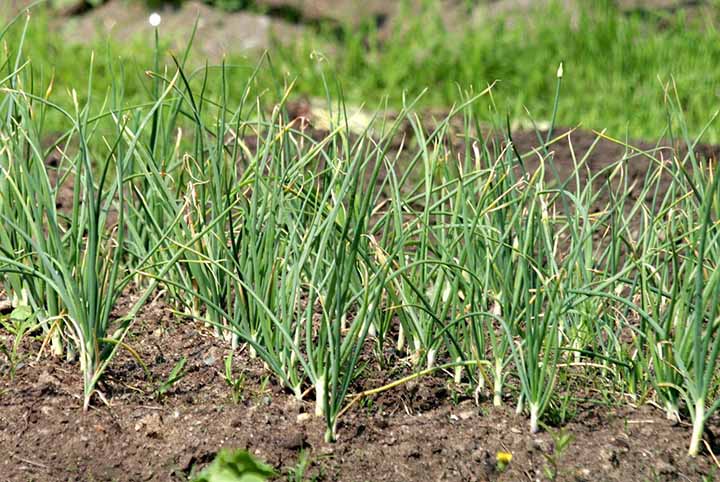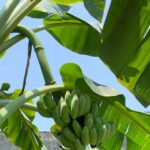Elephant garlic (Allium ampeloprasum) is more closely related to leeks than garlic. Elephant garlic produces huge bulbs and is very tasty. But, you may wonder, “When do I harvest elephant garlic?”
Elephant garlic is more like hard-necked garlic than soft-necked garlic. This is because the stalks are cut off after curing instead of being used to braid the cloves together.
When Do I Harvest Elephant Garlic?
Elephant garlic is ready to harvest 180-210 days after planting. After that, the bottom third of the tops will turn brown and die, while the top two-thirds will turn pale green. Waiting too long to harvest the garlic will mean the bulbs start to open and do not store well.
Indicators Elephant Garlic Is Ready to Harvest
Knowing when to harvest elephant garlic is a little more complicated than knowing when to harvest onions. But, here are some indicators it is time to harvest.
- It has been 180-210 days since the cloves were planted.
- The lower leaves will turn brown.
- The other leaves grow paler and light green.
- The tops start to die back, but two-thirds of the tops are still alive.
- The cloves should fill their skins if you pull a few test bulbs and cut them open.
Do not let the bulb flower before harvesting.
How Do I Harvest Elephant Garlic?
Elephant garlic should be dug up, not pulled up. Be very careful not to bruise the bulbs when harvesting them.
- Gently slip a garden spade or trowel under the garlic bulbs and dig them up.
- Brush the dirt off the bulb.
- Do not wash the bulb.
- Do not trim the roots or top.
- Use any cloves that are damaged or bruised immediately.
- Place the undamaged bulbs in the shade in a warm, dry place for one to three weeks to cure.
- Trim the roots.
- Cut the tops to leave 1-2 inches of stem on the bulb.
Can I Harvest Sprouting Elephant Garlic?
All elephant garlic has grown for at least six months before harvest. Therefore, it will have sprouted during that time.
How Do I Store Elephant Garlic Properly?
After trimming the roots and stems, store garlic in a cool area with temperatures of 32-40 degrees F. The humidity should be 60-70 percent. A refrigerator makes a good place to store your elephant garlic. If the elephant garlic is warm or is in the light, it will sprout. Elephant garlic will store for 6-9 months. For another crop, you can save the biggest bulbs to plant in the fall.
Getting Your Elephant Garlic from Planting to Harvesting

Elephant garlic takes a long time to grow, and lots can go wrong between planting and harvesting. Follow these tips to maximize your harvest.
Soil
Elephant garlic needs well-draining soil that is rich in organic matter. Follow these tips to prepare the bed where you will plant your garlic.
- Dig your soil up to a depth of at least six inches and preferably twelve inches.
- Work three inches of compost into the loosened soil. Do not use raw manure because it may contain harmful bacteria and weed seeds.
- If you have done a soil test, follow the recommendations for fertilizing before planting.
- Otherwise, spread urea (a type of nitrogen fertilizer) on the planting bed.
- Work the fertilizer into the first one to two inches of soil.
The pH of the soil should be 6.0-7.0 when you are done.
Planting
Purchase elephant garlic bulbs from a reputable nursery or seed dealer. Do not use elephant garlic from grocery stores. Grocery store elephant garlic is often treated so it will not sprout.
Elephant garlic is planted in the fall for harvest in late spring or early summer. The exact planting date depends on your location and how cold your winters are. Consult your local Extension Service or agricultural advisor for exact dates.
- Break the bulbs up into cloves a day or two before planting, being careful not to damage the skin on the cloves.
- Plant the cloves four inches apart.
- The rows should be eight inches apart.
- Plant the clove with the pointed end up.
- The elephant garlic cloves should be planted in a trench 1-2 inches deep.
- After planting, fill the trench with dirt.
- Water the elephant garlic bed after planting the cloves.
Light
Elephant garlic needs at least six hours of sun a day to grow. Therefore, it will not grow well in partial shade (2-4 hours of sun) and will not grow at all in the shade.
Water
Keep the soil around your elephant garlic moist but not soggy. If the garlic does not get enough moisture, the cloves will not fill out properly and will be smaller.
Water one inch a week when the garlic is growing. Stop watering when the tops of the garlic start turning yellow two weeks before harvest. Watering too close to harvest will make the garlic rot in storage.
Fertilizer
Ideally, you will do a soil test and get fertilizer recommendations based on the results. However, if you do not get a soil test, you must put down urea when you plant your garlic, as mentioned above.
When the sprouts appear in the spring, side dress the elephant garlic with another fertilizer application. You can use a balanced fertilizer such as a 10-10-10 for this if you do not have recommendations from a soil test. Then, fertilize again about four weeks later. Do not fertilize after that, or you may keep the bulbs from forming properly.
Weeding
Weeds rob your elephant garlic of water, nutrients, and sunlight. Keep weeds controlled around your elephant garlic, so the weeds do not choke out your garlic.
Elephant garlic has a shallow root system. Therefore, be very careful when weeding so you do not disturb the roots.
Mulch
Mulch helps conserve water, protect your elephant garlic from cold weather, and helps keep weeds from growing. After planting, mulch around the elephant garlic. You can remove the mulch in the spring until the soil warms up. After that, replace the mulch around the garlic cloves.
Fall Maintenance
If you live in a warm area, remove any flower stalks that try to form before winter. Then, you can eat these stalks like spring onions or scallions.
In warm areas, cover the elephant garlic with frost cloth when a frost is forecast before the first hard freeze. When it freezes, the garlic will go dormant until spring.
Pests of Elephant Garlic
Most pests will not bother garlic. Thrips may damage the leaves, but that rarely impacts the bulb. Bulb maggots can infest the bulbs but are seldom a significant problem.
Bloat nematode is a major problem for elephant garlic. Bloat nematodes are usually introduced by contaminated cloves. Make sure you buy your elephant garlic from a reputable source that certifies the garlic is disease and pest free. Rotate your garlic by not planting it anywhere that any member of the allium family (onions, leeks, etc.) has been planted for at least a year.
Diseases of Elephant Garlic
Bulb rot is usually caused by excessive rain or overwatering. Make sure the elephant garlic is planted in an area that drains well.
In summary, you harvest elephant garlic 180-210 days from when you plant it. The bottom third of the top turns brown while the other part turns pale green. Stop watering the elephant garlic when the bottom leaves of the top turn yellow so the garlic will store properly.






